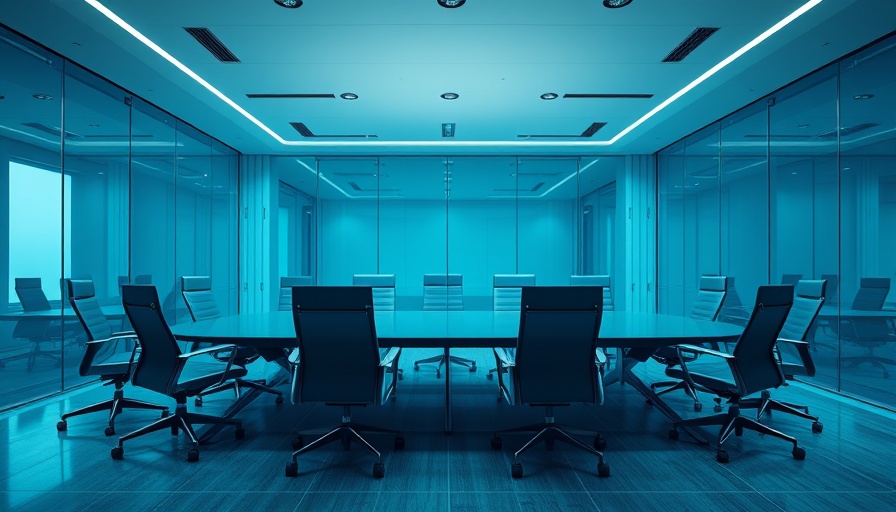
The Future of Workspaces: AI and Hybrid Trends Unveiled
As we look towards 2025, the evolution of workspaces across the United States is marked by a significant reimagining dictated by changing employee needs and technological advancements. A report from Envoy, a workplace design firm, sheds light on the key trends that are set to shape our work environments. With 76% of employees believing AI and machine learning will be transformative for workplace operations, it is clear that technology is poised to redefine our professional ecosystems.
Embracing AI and Automation: The New Work Landscape
The rise of AI isn't just a trend; it is a necessity for organizations seeking efficiency. The fact that 84% of employees agree that AI-powered tools drive productivity reflects the growing consensus on the role of technology in the workplace. Companies can maximize employee potential by utilizing AI to streamline routine tasks, thereby allowing staff to focus on more strategic activities.
This transition to AI-powered environments not only enhances productivity but also fosters innovation. As we navigate this shift, workplace leaders must consider how best to integrate AI into their operations and the implications this technology will have on employee roles and interactions.
High-Tech Hybrid Collaboration: Shaping Team Dynamics
With 60% of organizations emphasizing the importance of immersive technologies, the focus is increasingly on enhancing collaboration. Generation Z, for instance, is notably inclined towards tech-enabled spaces that facilitate teamwork. This shift not only changes the physical aspects of workplaces but also alters the culture, necessitating significant adjustments in how teams operate and connect.
As hybrid workplaces continue to gain traction, understanding how to effectively utilize technology to foster collaboration becomes paramount. For instance, implementing tools that allow for seamless virtual interaction can significantly enhance engagement and teamwork.
The Cost of Inertia: Why Sticking to Old Methods is Hazardous
Staying attached to outdated processes can exact a heavy toll on organizations. The revelation that manual operations can consume up to 30% of a company's revenue highlights the urgent need for adaptation. Businesses that resist change not only hinder their operational efficiency but also miss opportunities to innovate and grow.
The challenge is clear: companies must confront the inertia that comes with traditional practices and shift towards embracing new technology-driven approaches. This evolution is not just about survival; it is about staying competitive in a landscape that is rapidly changing.
Factors Shaping the Future: Insights from Leading Experts
As observed in the reflections of industry leaders, the move towards a hybrid workforce is not solely about the integration of AI, but about a holistic approach to how we organize work. According to Jeanne Meister, as AIs increasingly take on roles within teams, we’ll see a demand for AI-savvy management—it will be necessary to integrate AI oversight into traditional management structures.
Furthermore, discussions around workplace flexibility are evolving. The general consensus is that organizations adopting flexible work policies will attract the best talent, negating the pressures of harsh return-to-office (RTO) mandates. Leaders must base performance assessments on results rather than mere attendance, fostering an environment where productivity can thrive independent of location.
The Path Ahead: Predictions for Workplace Evolution in 2025
As we speculate on the future, several trends stand out. For starters, flexible organizations are likely to become the frontrunners in AI innovation. As documented, companies that successfully integrate flexibility into their work environment can also more effectively adopt generative AI technologies.
In addition, organizations will shift from a one-size-fits-all hybrid policy to tailored approaches that consider the unique needs of different teams and individuals. Retaining talent will necessitate a nuanced understanding of the factors driving employee satisfaction, including the desire for local adaptability in work arrangements.
Conclusion: Why Businesses Must Prepare for Change
The trends shaping the future of workplaces underscore the importance of readiness in change management. From adopting AI tools to fostering hybrid collaboration, the message is clear: organizations must be proactive in evolving their operations to meet the demands of modern-day professionals. Embracing these changes isn't merely an option; it's a requirement for success in a competitive landscape.
If you're a leader in your organization, now is the time to start adapting, investing in technology, and seeking innovative solutions to create a productive work environment that can thrive in the future.
 Add Row
Add Row  Add
Add 






Write A Comment